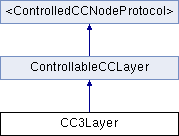CC3Layer is a cocos2d CCLayer that supports full 3D rendering in combination with normal cocos2d 2D rendering. More...
#import <CC3Layer.h>

Public Member Functions | |
| (void) | - initializeContols |
| (void) | - update: |
Properties | |
| CC3World * | cc3World |
Detailed Description
It forms the bridge between the 2D and 3D drawing environments.
The CC3Layer contains an instance of CC3World, and delegates all 3D operations, for both updating and drawing 3D models, to the CC3World instance.
In addition, like any cocos2d CCLayer, 2D child CCNodes can be added to this layer and will be rendered either over or under the 3D world, based on their individual Z-order. In particular, 2D controls such as menus, sprites, labels, health bars, joysticks, etc, can be overlayed on the 3D world simply by adding them as children of this layer. Similarly, a 2D backdrop could be rendered behind the 3D world by adding an appropriate CCNode as a child with a negative Z-order.
CC3Layer descends from CCLayerColor, and will draw a colored background behind both 2D and 3D content if configured with a background color. When using 3D objects that use alpha-blending, keep in mind that the background color does not participate in alpha-blending with 3D models that are drawn over it. The background color will not show through any semi-transparent 3D objects.
To make use of the standard cocos2d model updatating functionality to update and animate the 3D world, use the scheduleUpdate or schedule:interval: methods of CC3Layer to invoke periodic callbacks to the update: method of the CC3Layer instance. The update: method forwards these callbacks to the CC3World instance held by the CC3Layer.
CC3Layer is directly descends from ControllableCCLayer, which means that it can optionally be controlled by a CCNodeController instance. Doing so enables two features:
- Automatic rotatation the layer (both the 2D and 3D components) when the device orientation changes.
- The CC3Layer can be overlaid on a device camera image stream so that both the 2D and 3D worlds can participate in an augmented reality view perspective.
With the CCNodeController attached, either or both of these features can be turned on or off. If neither of these features is required, there is no need to instantiate and attach a CCNodeController, and the CC3Layer can be used without it.
For most applications, you will create subclasses of both CC3Layer and CC3World. The customized subclass of CC3World manages the behaviour of the 3D resources. The customized subclass of CC3Layer manages the 2D artifacts, such as menus, sprites, labels, health bars, joysticks, etc, that you want to overlay on the 3D scene.
Typically, you will create a separate instance of CC3World for each 3D scene. You can also create a distinct CC3Layer for each scene as well, or reuse a single CC3Layer instance across multiple CC3World scenes by simply assigning a differnt CC3World instance to the layer.
To create and use your CC3Layer and CC3World pair, follow these steps:
- Instantiate your CC3World class, including creating or loading 3D file resources in the initializeWorld method.
- Instantiate your CC3Layer subclass, adding any 2D controls in the initializeContols method.
- Attach your CC3World to the cc3World property of your CC3Layer.
- Invoke the play method of your CC3World to enable dynamic behaviour for the 3D world.
- Schedule regular updates in your CC3Layer instance by invoking either the scheduleUpdate or schedule:interval: method.
- Optionally create a CCNodeController.
- Run your CC3Layer instance either by invoking the runSceneOnNode: method of the CCNodeController with your CC3Layer, or by wrapping your CC3Layer in a CCScene and invoking the runWithScene: method of the shared CCDirector instance.
Member Function Documentation
| - (void) initializeContols |
Template method that is invoked automatically during initialization, regardless of the actual init* method that was invoked.
Subclasses can override to set up their 2D controls and other initial state without having to override all of the possible superclass init methods.
This default implementation does nothing. It is not necessary to invoke this superclass implementation when overriding in a subclass.
| - (void) update: | (ccTime) | dt |
This method is invoked periodically when the components in the CC3World are to be updated.
The dt argument gives the interval, in seconds, since the previous update.
This implementation forwards this update to the updateWorld: method of the contained CC3World instance. Subclasses can override to perform updates to 2D nodes added to this layer, but should be sure to invoke this superclass implementation, or to invoke updateWorld: on the cc3World directly.
Typcially this method is scheduled to be invoked automatically at a periodic interval by using the scheduleUpdate or schedule:interval: methods of this instance, but may also be invoked by some other periodic operation, or even directly by the application.
This method is invoked asynchronously to the frame rendering animation loop, to keep the processing of model updates separate from OpenGL ES drawing.
Property Documentation
- (CC3World *) cc3World [read, write, retain] |
The CC3World instance that maintains the 3D models and draws the 3D content.
The documentation for this class was generated from the following file:
 1.7.2
1.7.2